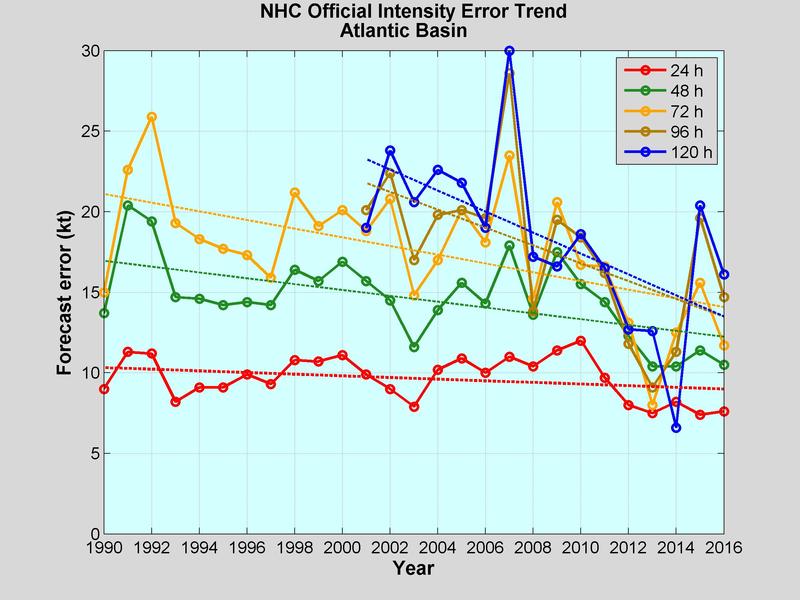|
Subject: F6) How accurate are the forecasts from the National Hurricane Center? Contributed by Chris Landsea and Miles Lawrence The National Hurricane Center (NHC) issues an official forecast, every six hours, of the center position, maximum one-minute surface (10 meter [33 ft] elevation) wind speed (intensity), and radii of the 34 knot (39 mph,63 kph), 50 knot (58 mph,92 kph), and 64 knot (74 mph,117 kph) wind speeds in four quadrants (northeast, southeast, southwest, and northwest) surrounding the cyclone. The NHC has been issuing predictions for the forecast periods of 12, 24, 36, 48, and 72 hours since 1964. Forecasts for 12 and 24 hours were first issued in 1954. In 2003, the forecasts were extended and now include 96 and 120 hours. All official forecast are verified by comparison with the "best track", a set of six-hour center positions and maximum wind speed values, that represents the official NHC estimate of the location and intensity of a tropical cyclone. A best track is prepared for every tropical cyclone, after the fact, using all available data.
Fig. 1Yearly-average (1989-2016) official track forecast errors for 24-, 48-, 72-, 96-, and 120-hours, Atlantic basin, excluding depressions. Straight lines are linear trend lines with all yearly-averages weighted equally. The official track error data includes all official forecasts issued since 1954. NHC's official track errors have averaged in the last few years about 85 nmi (100 st. miles,160 km) at 24 hr, 140 nmi (160 st. miles,260 km) at 48 hr and 200 nmi (230 st. miles,370 km) at 72 hr. One can see that NHC has even done better than these numbers during 2003. Forecasts are now also issued at 4 and 5 days lead time and these are likely to have an average error of about 250 nmi (290 st. miles,460 km) and 300 nmi (350 st. miles, 550 km), respectively. These are average errors so, of course, individual predictions may be substantially better or worse. It is to the National Hurricane Center's credit (and NOAA in general) that these predictions have gotten so much better in the last few decades, due to a combintation of more accurate numerical models, more observations over the open ocean, and a better understanding of the physics of hurricane movement. Today a 3 day forecast is as accurate as those issued for a 2 day prediction in the late 1980s.
 Fig.2 Yearly-average official intensity (1990-2016) forecast errors for 24-, 48-, 72-, 96-, and 120-hours, Atlantic basin, excluding depressions. Straight lines are linear trend lines with all yearly-averages weighted equally. NHC's wind intensity errors have averaged recently about 9 kt (10 mph,17 kph) at a 24 hr forecast, 15 kt (17 mph,28 kph) at a 48 hr forecast, and 19 kt (22 mph,35 kph) at a 72 hr forecast. The 4 and 5 day predictions should average about 21 kt (24 mph,39 kph) and 22 kt (25 mph,41 kph). (One comparison of the ability of the long-range forecasts is to consider that a simple prediction of a constant value of 60 kt (70 mph,110 kph) gives an error of about 23 kt (26 mph,43 kph), so forecasts with errors close to this value have little to no skill.) One does see that the intensity forecasts have improved somewhat at 1 and 2 day predictions - 48 hr forecasts today have errors that are 20% smaller than they were in the mid-1970s. However, the improvements are much slower than in the track predictions and the 3 day forecasts of intensity have not gotten substantially better at all. Much work still remains to better understand and predict wind intensity changes in tropical storms and hurricanes. Tropical cyclone size (that is, the radius of high winds) has been been forecasted by NHC for several years, though the first quantitative verifications have been provided just recently. These suggest that the errors in predicting the radius of gale force winds (34 kt,39 mph,63 kph) averages about 20 nmi (25 st. miles,35 km) at a 24 hr forecast, about 25 nmi (30 st. miles,45 km) at a 48 hr forecast, and about 30 nmi (35 st. miles,55 km) at a 72 hr forecast.
Last updated August 13, 2004 Back to Tropical Cyclones Forecasting Page | Back to Main FAQ Page |
TC FAQ
Links of Interest
AOML Tools & Resources
Employee Tools
|
